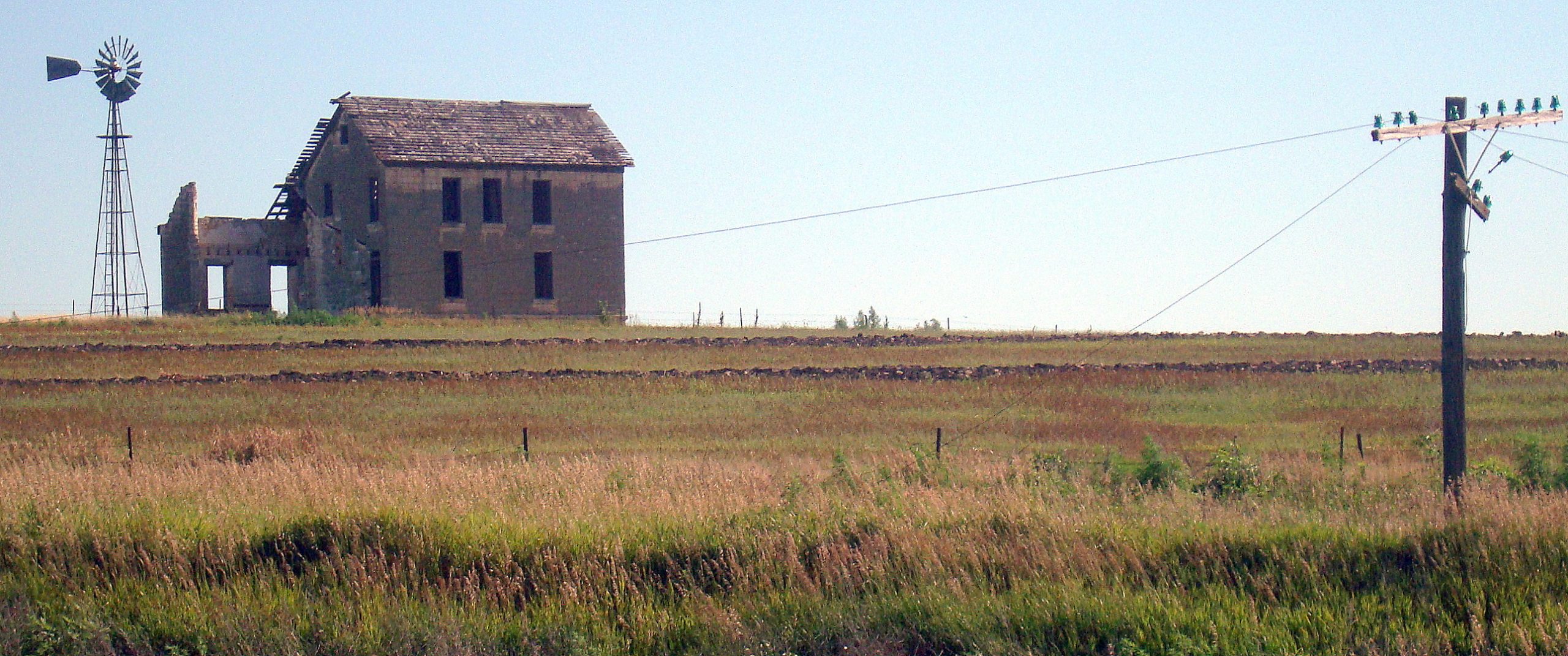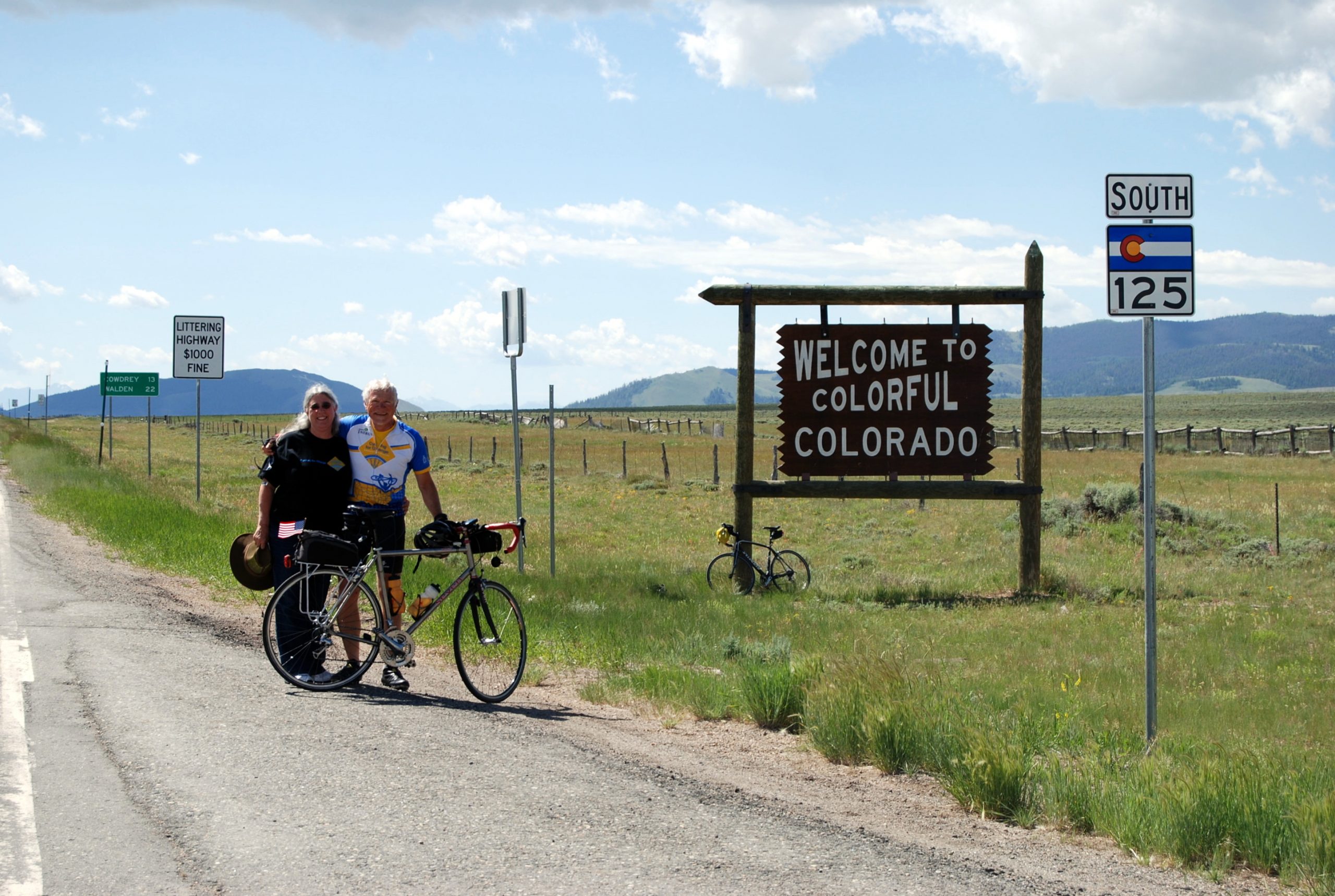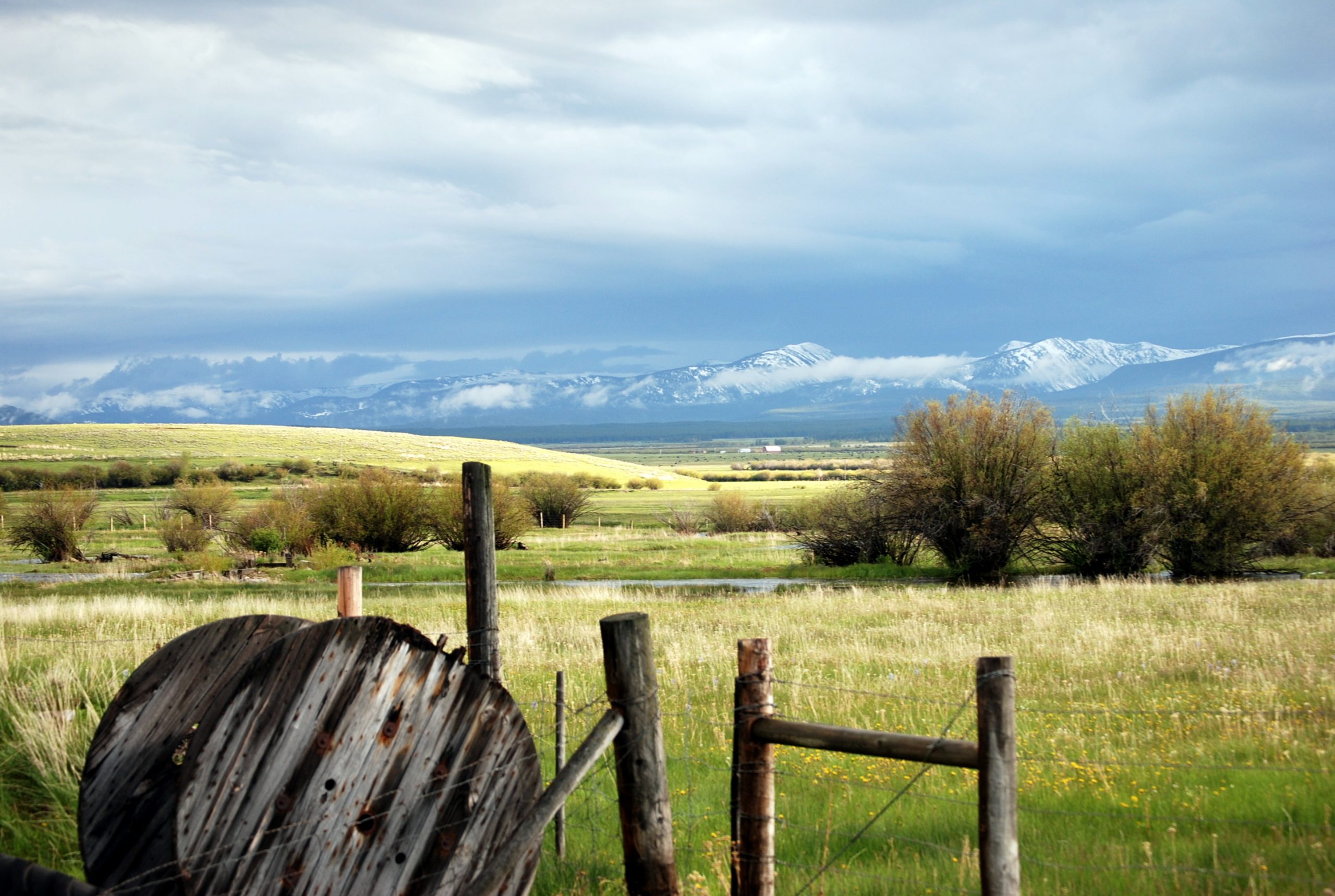
…at least Kansas is not flat from the seat of a bicycle.

On July 11, 2010, we entered Kansas embarking on a transit of nearly 500 miles that in 7 days would see us arriving in Kansas City, Missouri. Our route was almost exclusively on old US Highway 36. US-36 opened in 1921 was one of the original pre-Interstate thoroughfares that opening large swaths of the United States to automotive travel. It is not a true cross-continent highway as it begins it’s journey in Ohio and reaches its western terminus 1,400 miles later in Colorado’s Rocky Mountain National Park.

I-80 to the north and I-70 to the south have rendered US-36 a lightly travelled two lane country road that connects a string of small communities. In the west where we entered Kansas from Colorado the elevation was just under 4,000 feet above sea-level. By the time that we reached Kansas City, Missouri we had descended 3,000 feet. In the meantime the topography undulated across the plains and prairie land.

We frequently rated the difficulty of a day’s ride by the amount of vertical climb accomplished. In Colorado, Wyoming and the other western states climbs came in one long and very large effort. We found that in Kansas the total of vertical climb made good was equivalent to our experience in the mountain states, just in hundreds of small segments… “kind of a death by many cuts.”

Before the ride began, I had “predicted” to the team that at some point this would become labor. That transition occurred over the course of the 7 days that we crossed Kansas. Joes, Colorado gave us torrential rains.


Norton and Atwood in Kansas repelled us with relentless head winds. Smith Center, Kansas “treated” us to a heat index of 114 degrees. However, we would not be deterred as Kansas City drew us like a magnet. For most of us it represented home and a few days pause with family and friends. For all of us it was the completion of 2,500 miles of our 5,000 mile journey, the halfway point.

The final day ride, 60 miles from Atchison Kansas to the campus of Rockhurst in Kansas City was also special. In Atchison and Leavenworth we were joined by over 100 cyclists. Among those riders was my nephew, Phil Schloss, and members of the “Gravy Train”, cyclists with whom I regularly rode then and still ride to this day.






Smith Center, Kansas had a Dollar Store that I visited for some now forgotten need. As I approached the cashier my eyes were drawn to the impulse purchase rack. For only a dollar I became the proud owner of a bag of 100 huge, life-like, rubber roaches. Think Florida Palmetto Bugs, as seen here in comparison to the last of the plastic imitations that I still possess.


The rubber roaches each came to be known as “Henry”. For the 2,500 mile remainder of the C4C ride they bemused, befuddled, and generally terrorized the riders and occasional non-rider victims. Henry would show up in water bottles, clothing, bags of potato chips… and any other place that I could creatively (and anonymously) deploy him.
Early on I was considered a suspect, but one of the Henrys was overlooked only to be found on a day that I could not have been the perpetrator. My role in these pranks thus remained unknown until I confessed my guilt in Key West, Florida.
One morning in Clewiston, Florida I found a real Palmetto resting on the seat of my bicycle. I took the opportunity to carefully photograph the Palmetto alongside a “Henry”. Removing the fake bug I left the real one in place. Soon one of the riders saw “Henry”. In disgust the rider grabbed him with a mind to show everyone that yet another “bug” had been found. Unfortunately, it was not “Henry” that was held closed in the palm of the rider’s hand, but the real Palmetto Bug. I wish that I could have recorded the yell that pierced the air as the huge insect struggled to escape the rider’s grasp.

At the end of this post is a reflection on a memorable personal experience that also occurred in Smith Center, Kansas.
Next: Missouri’s KATY Trail
Peace Everyone. Pete
July 13, 2010. The Nine Dollar Haircut
Today was hot. Not just hot, but HOT!
“How hot was it, Pete?”
So hot that the roll of my bicycle wheels gave the continuous sound of separating Velcro as the sun-beaten asphalt reluctantly released its grip, revolution after revolution.
So hot that colors appeared bleached into the dull grey of sepia photos by the arc-welder brightness of the midday sun.
So hot that…
Prudently, we awoke early and had the vans packed with our luggage by 6 a.m.. Arrangements had been made with a local diner in Norton, Kansas to accommodate the 17 of us for an early breakfast. The goal was to eat and then be on the road via US 36 to the town of Smith Center by 7 a.m.. 61 miles separated these towns and the prediction was for the temperature to break the century mark. Mercifully, the headwinds of the prior day had moderated into tolerable side winds that had the intermittent character of gusts from the mouth of a blast furnace.
We arrived in Smith Center shortly after noon. Our motel, The Buckshot Inn, was cast in the mold of countless motels that sprang up in the heyday of the old US Highway system. As with its more famous sibling, “Route 66”, US 36 was once a primary link for commerce and travel across the United States. These roads, wonders of the first half of the 20th Century, have long been eclipsed by President Eisenhower’s visionary network of Interstate Highways. US 36 is now mostly frequented by local travelers, huge lumbering farm combines, and today by our bicycles. Most of the motels are gone, but the ramshackle remains of some are still visible as ghostly reminders of an earlier era. The Buckshot Inn survives and thrives thanks to the attention, care, and maintenance of its owners. To our delight, the line of rooms faced a small yard and a blue turquoise concrete swimming pool. The crystal clear water invited us to make its depths our first non-cycling activity of the day.
Refreshed, our focus shifted to finding a late lunch. The urgency of the mornings ride had caused us to skip our usual meal break. Christine and I went into the old downtown area to seek a diner.
Downtown Smith Center is not dead, but like many historic central business districts it is not well. The two and three story brick and stone structures harken to a time when a building’s name and year of “birth” were prominently displayed at the top and on the cornerstone. One such building in Smith Center is the Shite Building, 1888. Another, The First National Bank building, displayed “Founded 1886, Erected 1930”. That was a tough year to build a bank, but clearly The First National Bank had successfully weathered the adversity of the Depression. Faded paint indicated the character of some of the long gone businesses. Much of the former commerce has been replaced by antique and secondhand stores. A modern addition to the bank facade informed us of the time, 2 p.m., and the temperature, 101.
We ate at the Second Cup Café, where $6 can still buy you a large tenderloin sandwich with all the trimmings, and a piece of homemade pie (Apple, with Maple flavored crust, fantastic!). A patron asked if we were with “the cycling group”. After a pleasant discussion with her and the café owner, she smiled and gave us a $5 donation and a “God Bless You”. We left the café and were again assaulted by the wall of heat. Across the street I saw a small, faded barber’s pole mounted next to the door of an old and timeworn storefront. “Paul’s Barbershop”. It had been over 6 weeks since my last haircut, and curiosity got the best of me. I crossed the street to peer into the window. Over the years the glass had lost its clarity, etched by countless dust storms. I shaded my eyes against the glass in order to better see within. I beheld not just a barbershop, but a living “barbershop museum” with one of our riders, Jeremy, in the barber’s chair.

We entered the shop. It was a “three chair” store, each of which was a creature of cast iron, nickel, porcelain and leather nearly 100 years old. Jeremy was in the center chair, but what immediately drew my eye was that the chair to the left was a fully functional chair in miniature… the perfect size for a 5 year old and elevated to the perfect height for Paul the Barber. This tonsorial “throne”, fit for any young prince, differed from its larger brothers only in the absence of the long leather razor strops which hung from the full size chairs.

“Atmosphere” was provided by a mahogany encased, single dial radio which still used vacuum tubes to amplify the broadcast signal. An older console version stood near the back of the store. The service counter displayed bottles of men’s grooming products such as Vitalis Hair Tonic, Krew-Kut, Hask Hair Tonic, and a few other brands that I had thought long extinct. Behind the counter was a very old ornate white and chrome cash register… the kind that shoots little metal “tombstones” up at the sound of a bell to announce the amount of the transaction. I would soon learn that the register remained in use. Then there was Paul, the shops sole proprietor.
I suspect that in Paul’s younger days he had been at least 6 feet tall, but 7 decades and bending over countless heads of hair had taken their toll. As he focused his attention on cutting Jeremy’s hair I noticed a tremor in Paul’s hand that seemed to stop just at the moment the clippers reached their destination. Barbers are observant of people and human nature, and Paul was no exception. He seemed to read my mind and commented in a matter of fact manner that he had suffered a stroke but was able to pursue his calling after only 6 months of recuperation. Paul was confident of his skills to the point that he made jokes, “If I make a mistake, the hair will just grow back”… “If you want something fixed, you can always ride your bikes back here”… Paul and I were amused. Jeremy’s half-smile gave just a hint of reserved nervousness. I sensed that my wife, Christine, preferred that I leave my hair to other hands.
Paul put the finishing touches on Jeremy’s hair-cut, and with practiced mastery removed the barber’s cape, shaking the clinging hair to the floor. “That will be nine dollars”, Paul announced. Jeremy and I both must have displayed a micro reaction, as Paul then followed up with, “I could do it cheaper, but only if you fellows pay my bills.” Now, it has probably been over 30 years since I had a $9.00 haircut, and here Paul had assumed we were suffering sticker shock.
I took my turn in the chair. Paul went to work as a craftsman should, with calm practiced confidence. We talked as he cut.
“So you fellows are Catholic. Well, I’m Lutheran, which is kind of watered down Catholic.” He stopped and chuckled.
“Was a time there weren’t many Catholics in this area, but there are sure a lot of them now”. He was making a matter of fact observation. There was no animus in the statement.
I asked Paul for a recommendation for a dinner restaurant. “Well, I prefer to eat with Mom (his wife) at home, but I suppose if I had to eat somewhere else it would be Putches or Duffy’s downtown here.” We ate at Duffy’s, and Paul’s recommendation was spot on.
I learned that Paul and his wife had celebrated 50 years of marriage in June. They had two daughters, a son, and one grandson. This was Paul’s second barber shop and he had been cutting hair in his “new” shop since 1962. He confirmed that the chairs, register, and fixtures predated his arrival. It was at this point that Paul became serious. “There have been many people over the years who have offered to buy my chairs, cash register, and other items.” He and “Mom” had talked about it, but it just didn’t seem right. The shop was his business and his life. He just couldn’t see parting with it piecemeal. With sadness he remarked that in front of the shop there once stood a tall barber’s pole that was as old as the shop itself. About 8 years ago some fellows passing through town wanted to buy it. Paul politely declined to sell. “I was in the shop Saturday, and by Monday the pole was gone. Someone stole my barber pole”. Paul declined to blame “those fellows”, or anyone else. He just remarked, with a hint of sadness that maybe someone needed it more than he did.
“What do you think?” asked Paul. “About the barber pole?” I replied. “No, the haircut! Is it ok?” I smiled and looked in the cracked and time worn wall mirror at the white skinned border that now separated my bicycle tan from my shortened hairline. “Paul, it looks great!” Paul beamed and said, “That will be nine dollars.” I gave him a ten… “Please keep the change”. His smile broadened, broken only by the word, “Thanks!”

As I left the shop I considered that my ten dollars had purchased a haircut and a moment in the life of a good and extraordinary man. Smith Center had the fortune of Paul’s good will for over 50 years. “Mom” had enjoyed his love and company for over 50 years. How rich the community and how rich his family. My 15 minutes in his chair were priceless. I wish I could take my grandchildren there just once. You know that tonsorial “throne”, fit for any young prince (or princess). I wonder if children’s haircuts are also nine dollars. Let’s see, that would be $90.00 plus the tip… What a bargain.
-Pete Schloss
A sad update to my reflections on Paul…





























































































































